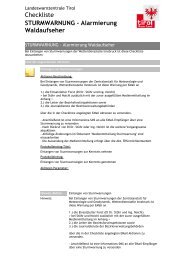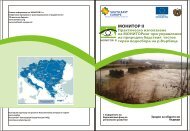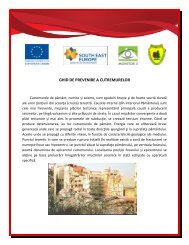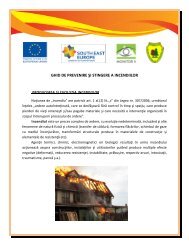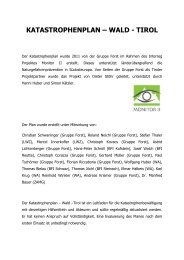risk management - monitor ii
risk management - monitor ii
risk management - monitor ii
You also want an ePaper? Increase the reach of your titles
YUMPU automatically turns print PDFs into web optimized ePapers that Google loves.
4 Monitor II Risk <strong>management</strong> introduction<br />
Monitor II Risk <strong>management</strong> introduction 5<br />
Picture 1: Situation outside dambreak (Evros river, Greece)<br />
The context:<br />
<strong>risk</strong> <strong>management</strong><br />
Natural hazards and disasters<br />
Physical world – what happens<br />
Starting point for terminology development<br />
is the basic interrelation between the<br />
environment and events changing the<br />
environment: the physical world describes the<br />
“objective” world of objects, events and the<br />
impacts of events on objects.<br />
Natural hazards account for a substantial<br />
and growing proportion of disasters in Europe.<br />
Between 1998 and 2002 alone, Europe<br />
suffered over 100 major damaging floods,<br />
including the catastrophic floods along the<br />
Danube and Elbe rivers in 2002. Since 1998,<br />
floods have caused some 700 fatalities, the<br />
displacement of about half a million people<br />
and at least € 25 billion in insured economic<br />
losses (http://ec.europa.eu/environment/<br />
water/flood_<strong>risk</strong>/impacts.htm). In reaction to<br />
the floods of 2002 the European Union has<br />
started an initiave in order to mitigate the<br />
effects of these hazards – the Floods Directive<br />
(Directive 2007/60/EC of the European<br />
Parliament and of the Council of 23 October<br />
2007 on the assessment andf <strong>management</strong> of<br />
flood <strong>risk</strong>s). For hazards related to floods this<br />
directive defines several obligatory measures of<br />
<strong>risk</strong> <strong>management</strong>.<br />
Risk <strong>management</strong> aims at preventing or<br />
r educing damages resulting from hazardous<br />
events. As any other domain of expertise it<br />
uses a wide range of terms, which are quite<br />
often used in an ambiguous way. Ambiguity<br />
is a direct result of the broad range of actors<br />
involved in disaster <strong>management</strong>, the splitting<br />
of competences and the heterogeneity of<br />
experts and fields of expertise involved. In<br />
addition, actors, competences and fields of<br />
expertise usually change between the phases<br />
of <strong>risk</strong> <strong>management</strong> – leading to disruptures of<br />
communication, knowledge <strong>management</strong> and<br />
activities.<br />
As a result practical experience shows that<br />
some of the definitions are not fully clear to<br />
the actors and are often used somehow<br />
contradictionary. Therefore a short introduction<br />
with a clear and concise definition is<br />
given below for those terms used within the<br />
MONITOR II approach.<br />
Figure 1: Risk <strong>management</strong> terms: real world (S. KOLLARITS et al. 2007)<br />
If objects of the environment participate in<br />
events (which actually means a spatio-temporal<br />
co-location) we talk about exposure, they are<br />
exposed to these events. Events happen within<br />
this environment and cause impacts.<br />
An impact “changes” (qualities of) the<br />
environment. A change of quality in this<br />
context may include substantial changes like<br />
generation and destruction of objects.<br />
The main terms associated with the physical<br />
world are objects (of the environment), events<br />
and impacts. These are related to each other by<br />
exposure, causation and effect.<br />
Social world – how is the physical<br />
world interpreted<br />
People perceive and evaluate events and<br />
their impacts on the environment in heterogeneous<br />
ways. There is not a single unified<br />
view of how these impacts are to be evaluated.<br />
Social concepts classify elements of the real<br />
world in order to make them communicable<br />
and knowledge interchangeable. Without



